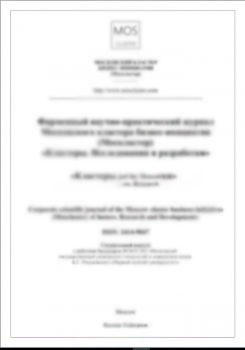, Russian Federation
Russian Federation
GRNTI 50.07 Теоретические основы вычислительной техники
BBK 3297 Вычислительная техника
This paper describes a semantic approach to visualization of 3D cyberspace of Artificial Intelligence (AI) publications and their topic trends evolution using web-based 3D graphics. The purpose of research is to group AI publications with same subject into clusters for further visualization of topic trends dynamics. An unsupervised method and algorithm for visualizing the dynamics of topic trends by generating a time series of 2D and 3D semantic visual maps with predictive information is described. The method includes semantic similarity measure and citation prediction for documents, topic modeling and clustering, dimensionality reduction, virtual reality technology, representation of dynamics using time filters. As an example of particular implementation, the method is demonstrated on AI collection data using technologies of neural network prediction, LDA clustering, t-SNE dimensionality reduction, WebVR visualization. Cluster dynamics associated with scientific trends is analyzed. The growth in number of clusters and their consolidation during the period from 1954 to 1993 is demonstrated. It is shown that 3D visual map better preserves articles similarity and highdimensional clusters structure than 2D visual map. The proposed cyberspace implemented by WebVR and interactive 3D graphics can be considered as a dynamic learning environment that is convenient for discovering new significant articles, ideas and trends.
virtual reality, web-based 3D graphics, WebVR, scientific papers, topic modeling, dynamics of topic trends, semantic similarity, visualization, visual map
1. O. Abdelwahab and A. Elmaghraby. UofL at SemEval-2016 Task 4: Multi Domain word2vec for Twitter Sentiment Classification. In Proceedings of the 10th International Workshop on Semantic Evaluation (SemEval-2016). Association for Computational Linguistics, 2016, pp. 164– 170. https://doi.org/10.18653/v1/S16-1024
2. M. Dodge and R. Kitchin. Exposing the Second Text of Maps of the Net, Journal of Computer-Mediated Communication 5, 2000, http://www.ascusc.org/jcmc/vol5/issue4/ dodge_kitchin.htm
3. M. Charnine, S. Klimenko, "Semantic cyberspace of scientific papers," Proc. 2017 International Conference on Cyberworlds, 20-22 September 2017, Chester, United Kingdom, pp.146-149.
4. C.Chen, "Structuring and visualizing the WWW with Generalized Similarity Analysis", Proceedings of the Eighth ACM Conference on Hypertext (Hypertext’97), 1997, Southampton, UK, pp. 177-186.
5. C.Chen, "Visualization of knowledge structures", Handbook of Software Engineering and Knowledge Engineering, 2002.
6. S.Klimenko, M.Charnine, O.Zolotarev, N.Merkureva, A.Khakimova, "Semantic approach to visualization of research front of scientific papers using web-based 3D graphic," Proc. 2018 International Conference Web3D’18, June 20–22, 2018, Poznan, Poland.
7. L.J.P. Maaten van der and G.E. Hinton. Visualizating data using t-SNE. Journal of Machine Learning Research, 9(Nov), 2008, pp. 2579–2605.
8. T. Mikolov, G. Corrado, K. Chen, and J. Dean. Efficient Estimation of Word Representations in Vector Space, 2013, Vol. 1, pp. 1–12.
9. S. Neelakantam and T. Pant. Learning Web-based Virtual Reality: Build and Deploy Web-based Virtual Reality Technology. 2017.
10. H.Patel, R.Caedinali "Virtual Reality Technology in Business", Management Decision, 1994, 32, 7, 5-12.
11. J. Tian and M. Lan. ECNU at SemEval-2016 Task 1: Leveraging Word Embedding From Macro and Micro Views to Boost Performance for Semantic Textual Similarity. In Proceedings of the 10th International Workshop on Semantic Evaluation (SemEval-2016). Association for Computational Linguistics, 2016, pp. 621– 627. https://doi.org/10.18653/v1/S16-1094.





